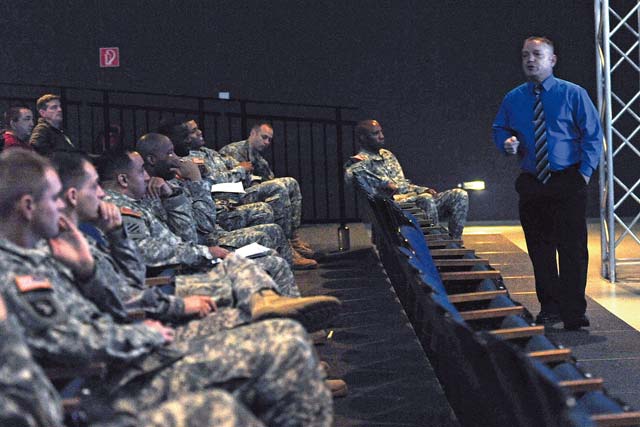
When mentioned, most simply think of the stereotypical auditorium, a slide-show presentation to be ignored and the glazed over look in the audience’s eyes. It is a topic synonymous with terms like “quarterly training,” “mandatory” and “death by presentation.” In reality, the concept of Sexual Harassment/Assault Response and Prevention is deserving of much more attention.
The 21st Theater Sustainment Command SHARP coordinators work in conjunction with U.S. Army Garrison Rheinland-Pfalz to raise awareness of sexual assault and harassment trends and prevention in the KMC.
The “First in Support” command manages the SHARP hotline and keeps it staffed with SHARP representatives and victim advocates from units throughout the community 24-hours a day. They also have two SHARP coordinators responsible for managing training and raising awareness throughout the organization.
The trends and demographics of sexual assault remain the same Army-wide. Typically, assaults occur in a barracks environment, alcohol is involved and the crime is “Soldier on Soldier.” To curb this problem, SHARP representatives and victim advocates believe that education is the key, said Sgt. 1st Class Mary S. Brown, a 21st TSC SHARP coordinator.
“Once the SHARP directive was initiated, more and more people stepped forward and talked about their experiences and what happened to them with regards to sexual assault,” Brown said. “It brings to light that the Army and all the branches of service have a problem with sexual harassment and assault and the only way to stop it is to educate our Soldiers.”
The education process began like so many Army training programs do, with slide presentations made mandatory by policy.
Soldiers sign in on a roster and are subsequently bombarded with plain text on a screen, listing
statistics, Army regulations and policies. It was not as effective as many would hope, Brown said.
“We are moving away from what the Soldiers know as ‘death by presentation,’” Brown said. “Instead of herding Soldiers into crowded auditoriums to look at an hour-long slide show, we want to bring the training to a more personal level with vignettes, film clips and, most importantly, small group and unit involvement.”
The new method of training involves revised slide presentations spliced with realistic and slightly graphic video clips. The presentations are used in conjunction with small group education and inter-Soldier discussions. The goal is to show Soldiers that this is a concern from the highest level, right down to theirs, Brown said.
“If the Soldiers see their supervisor discussing these issues with them, it hits home that this is a large issue,” Brown said. “In these discussions, the Soldiers have a voice and can speak their opinion on the matter. It prepares them to speak out and intervene if necessary.”
Many SHARP coordinators and victim advocates say the new training system is more effective and impacts the Soldier on a more personal level. The videos and vignettes show the need for Soldier action instead of an “innocent bystander” mentality. All this combined with leadership involvement is the key to success, said Jonathan R. Trussell, the 21st TSC’s 16th Sustainment Brigade SHARP victim advocate.
“It’s unfortunate that this training ever received a ‘check the block’ classification, but it is something we can change,” Trussell said after a training session with the 21st TSC headquarters. “We are getting away from the presentations and our leaders are getting involved and are getting motivated. We need to make this real. It is a real issue throughout the military.”
Soldiers receiving the revised training are responding.
“Slide presentations are almost always repetitive,” said Spc. Derreck K. Gay, a wheeled vehicle mechanic with the 21st TSC headquarters. “The videos they showed during this training made it a little more real. It shows that this is an issue and that we as Soldiers can stop it.”
Sexual harassment and assault are an important concern for the Army and 21st TSC’s SHARP program is one resource for the KMC. The program hotline, authority and training are an effort to bring the reality, consequences and prevention techniques of SHARP to all service members and their families. They will continue to show all members of the community that they can be “the force behind the fight.”


